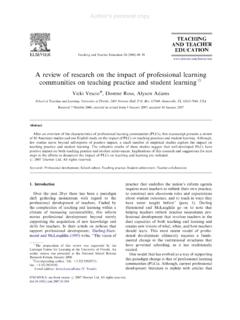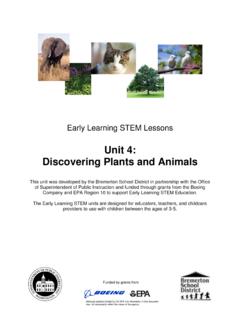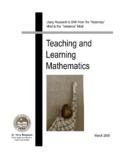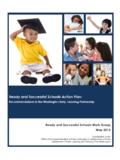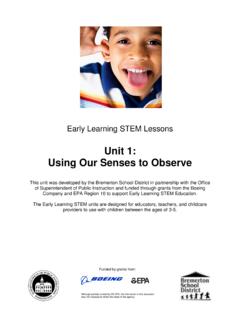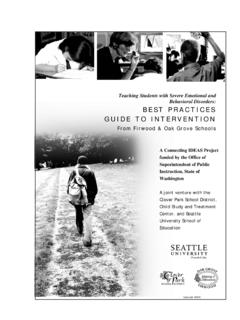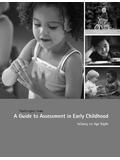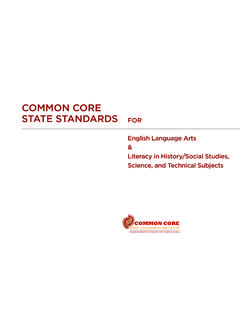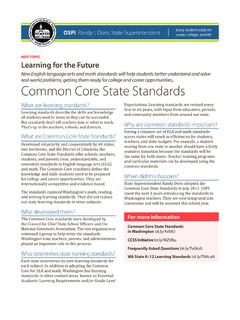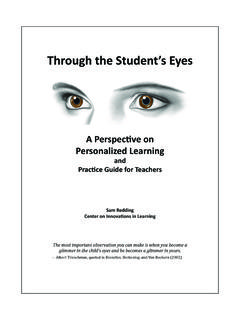Transcription of Hi there! We've made a few changes and want to get you to ...
1 Hi there! We've made a few changes and want to get you to the right document. The Washington State Early learning and Development Guidelines, published in 2012, have replaced the 2005 Benchmarks. However, if you're still in need of the 2005 Benchmarks, they begin on page 2 of this document. For questions about either document, please contact OSPI Early learning at (360) 725-4952. Washington State Early learning and Development Benchmarks A Guide to Young Children's learning and Development: From Birth to Kindergarten Entry Funding for the creation of the Washington State Early learning and Development Benchmarks originated from two federal sources: The Department of Health and Human Services, Administration of Children and Families, Head Start Bureau, Head Start-State Collaboration Of ce, which supports partnerships between Head Start and other early childhood programs, services, and initiatives; and The Department of Education, Even Start Family Literacy Program administered through the Of ce of the Superintendent of Public Instruction.
2 The Even Start Family Literacy Program is intended to help break the cycle of poverty and illiteracy and improve the educational opportunity of low-income families. 2005 The State of Washington. This document may be freely reproduced without permission for non-pro t, educational purposes. Use of or reference to this document should cite: Washington State Early learning and Development Benchmarks. The State of Washington. 2005. Early learning and Development Benchmarks A Guide to Young Children's learning and Development: From Birth to Kindergarten Entry Prepared for: Washington State's Early learning and Development Benchmarks Advisory Panel Authors: Sharon Lynn Kagan, Pia Rebello Britto, Kristie Kauerz, Kate Tarrant, National Center for Children and Families, Teachers College, ColumbiaUniversity Development of the Washington State Early learning and Development Benchmarks is a partnership between the Of ce of the Governor and the Of ce of Superintendent of Public Instruction (OSPI), and is sponsored by the Head Start-State Collaboration Of ce, OSPI, Department of Social and Health Services and the Department of Community, Trade and Economic Development.
3 Core State Interagency Team Gary Burris Marcia L. Riggers Division of Child Care and Early learning Of ce of Superintendent of Public Instruction Acknowledgements Sangree M. Froelicher Governor's Head Start-State Collaboration Of ce Lynne Shanafelt Department of Community, The Of ce of the Governor and Trade and Economic Development Lorrie Grevstad the Of ce of Superintendent of Department of Health Debra Williams-Appleton Public Instruction (OSPI) would Of ce of Superintendent of Public Instruction like to give special thanks to the Rachael Langen Core State Interagency Team and Division of Child Care and Early learning Robin Zukoski the Benchmarks Advisory Panel Governor's Executive Policy Of ce for guiding the development process of the Benchmarks.
4 The Advisory Panel Core Team and the Advisory Panel Sue Anderson Sheau-Pyng Li were also contributing reviewers Comprehensive Health Education Foundation Child Care Licensor and editors. Additionally, many thanks go out to the other Bill Blair Angelia Hicks-Maxie organizations and individuals Cascade Elementary, Chehalis School District Tiny Tots Development Center (over 1,000) who provided Melinda Brennan Margy Miller further review and input. Walla Walla Community College Region X Head Start Training & Technical Susan Bresnahan Assistance System Special Education, Spokane Public Schools Mary Perkins Bridgett Chandler Early Childhood Special Education, Educational Service District 113. Talaris Research Institute Cheri Raff John Chattin-McNichols Centralia College Seattle University Wendy Roedell Enrique J.
5 Garza Puget Sound Educational Service District Early Childhood Education, WA State Migrant Council Jada Rupley Educational Service District 112. Richard Gomez Migrant and Bilingual Education, OSPI Jill Sells Pediatrician and Consultant Deborah J. Handy Washington State University Kris Slentz Western Washington University Maxine Hayes State Health Of cer, Department of Health Linda Sullivan-Dudzic Special Programs, Bremerton School District Lorri Hope Family Home Child Care Provider Karen Walker Early Childhood Special Education, OSPI. Maryann Johnston WA Association for the Education of Young Children Patsy Whitefoot Indian Education, Deborah Kautz Educational Service District 105. Nisqually Indian Tribe Janice Yee Jean Kelly WA State Association of Head Start and ECEAP.
6 University of Washington Joan Yoshitomi Garrison Kurtz Family Engagement, OSPI. Foundation for Early learning Mickey Venn Lahmann Curriculum and Instruction, OSPI. Table of Contents PAGE. Introduction ..1. Domain 1: Physical Well-Being, Health, and Motor Development ..15. Motor Development ..20. Gross Motor Skills 1 Children demonstrate strength and coordination of large muscles Fine Motor Skills 2 Children demonstrate strength and coordination of small muscles Sensorimotor Skills 3 Children use their senses (sight, hearing, smell, taste, and touch) to guide motions Physical Physical Fitness 4 Children demonstrate the stamina and energy to participate in daily activities 5 Children engage in a variety of physical activities Health and Personal Daily Living Skills 6 Children practice basic personal care routines 7 Children demonstrate personal health and hygiene skills Nutrition 8 Children eat a variety of nutritious foods Safety.
7 36. Safe Practices 9 Children demonstrate knowledge about and avoid harmful objects and situations Rules and Regulation 10 Children demonstrate awareness and understanding of safety rules Domain 2: Social and Emotional Development ..41. Social Interactions with Adults 11 Children trust and interact comfortably with familiar adults 12 Children seek assistance from adults when needed Interactions with Peers 13 Children develop friendships with peers 14 Children cooperate with peers 15 Children demonstrate positive negotiation skills Adaptive Social Behavior 16 Children demonstrate awareness of behavior and its effects 17 Children participate positively in group activities 18 Children adapt to diverse settings 19 Children demonstrate empathy for others and the natural world Appreciating Diversity 20 Children recognize, appreciate.
8 And respect similarities and differences in people Emotional Self-Concept 21 Children perceive themselves as unique individuals 22 Children demonstrate awareness of their abilities, characteristics, and preferences Self-Ef cacy 23 Children demonstrate belief in their abilities Self-Control 24 Children understand and follow rules and routines 25 Children regulate their feelings and impulses Emotional Expression 26 Children express appropriately a range of emotions Domain 3: Approaches Toward learning ..82. Curiosity and Interest 27 Children are curious about and interested in learning new things and having new experiences Initiative 28 Children demonstrate initiative Persistence and Attentiveness 29 Children sustain attention to tasks and persist when facing challenges Creativity and Inventiveness 30 Children approach daily activities with creativity and inventiveness Re ection and Interpretation 31 Children learn from their experiences Domain 4: Cognition and General Knowledge.
9 93. Logic and Reasoning ..96. Causation 32 Children demonstrate awareness of cause and effect Critical and Analytic Thinking 33 Children compare, contrast, examine, and evaluate experiences, tasks, and event 34 Children use past knowledge to build new knowledge Problem Solving 35 Children nd multiple solutions to questions, tasks, problems, and challenges Representational Thought 36 Children use symbols to represent objects 37 Children distinguish between fantasy and reality Mathematics and Numbers and Operations 38 Children demonstrate knowledge of numbers and counting Measurement 39 Children demonstrate knowledge of size, volume, height, weight, and length Properties of Ordering 40 Children identify and label shapes 41 Children sort, classify, and organize objects.
10 116. Scienti c Thinking 42 Children collect information through observation and manipulation 43 Children engage in exploring the natural world by manipulating objects, asking questions, making predictions, and developing generalizations Scienti c Knowledge 44 Children observe and describe characteristics of living things 45 Children observe and describe characteristics of the earth Social Studies ..124. History 46 Children differentiate between events that happen in the past, present, and future Geography 47 Children demonstrate awareness of location and spatial relationships 48 Children demonstrate knowledge of the relationship between people, places, and regions Economics 49 Children demonstrate awareness of economic concepts Ecology 50 Children demonstrate awareness of the relationship between humans and the environment Technology 51 Children use technology appropriately Family, Community, and Culture.
